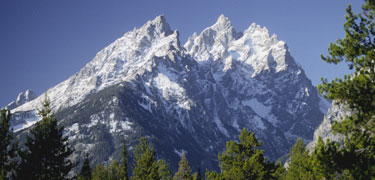
Click here to read about our cabin.
Located in northwestern Wyoming, Grand Teton National Park protects stunning mountain scenery and a diverse array of wildlife. The central feature of the park is the Teton Range — an active, fault-block, 40-mile-long mountain front. The range includes eight peaks over 12,000 feet (3,658 m), including the Grand Teton at 13,770 feet (4,198 m). Seven morainal lakes run along the base of the range, and more than 100 alpine lakes can be found in the backcountry.
Elk, moose, pronghorn, mule deer, and bison are commonly seen in the park. Black bears are common in forested areas, while grizzlies are occasionally observed in the northern part of the park. More than 300 species of birds can be observed, including bald eagles and peregrine falcons.
The elevation of the park ranges from 6,400 feet on the sagebrush-dominated valley floor to 13,770 feet on the windswept granite summit of the Grand Teton. Between the summit and plain, forests carpet the mountainsides. During summer, wildflowers paint meadows in vivid colors. Crystalline alpine lakes fill glacial cirques, and noisy streams cascade down rocky canyons to larger lakes at the foot of the range. These lakes, impounded by glacial debris, mirror the mountains on calm days. Running north to south, the Snake River winds its way down the valley and across this amazing scene.
Long, snowy, and bitterly cold winters make the climate of Jackson Hole unforgiving. The coldest temperature ever recorded in Grand Teton National Park was –63°F, and snow often blankets the landscape from early November to late April. Brief, relatively warm summers provide a respite from the rigors of winter and a time of renewal and rebirth. In cooperation or competition, the plants and animals adapt to this harsh climate and dramatic elevation change as each finds ways to survive.
FOR MORE ON GRAND TETON NATIONAL PARK SEE: http://www.nps.gov/grte/home.htm